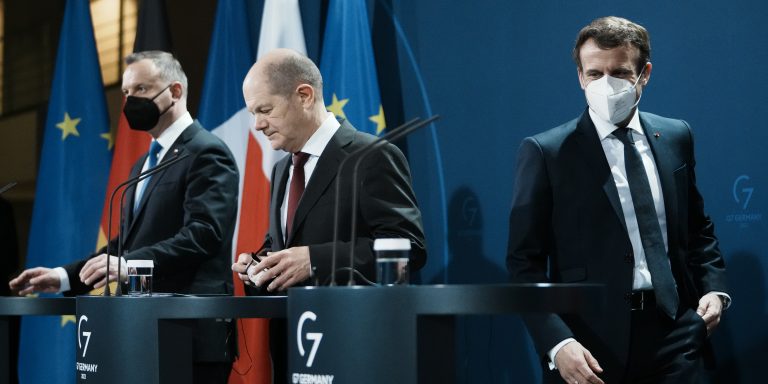INTELBRIEF
February 10, 2022
IntelBrief: U.S. and European Allies Show Resolve as Russia Keeps Ukraine on Edge

Bottom Line Up Front
- The tense standoff between Russia and Ukraine continues to drag on, with European countries ramping up diplomatic efforts this week in an attempt to head off conflict.
- German Chancellor Olaf Scholz sought to demonstrate that Berlin and Washington were on the same page, attempting to assuage doubters who have been calling Germany weak for failing to take a hard line with Russia.
- French President Emmanuel Macron met with Polish, Russian, Ukrainian, and German leaders earlier this week in an attempt to defuse tensions, although the results have mostly been inconclusive to date.
- While diplomatic efforts continue, Russia has wasted no time in preparing for conflict, dispatching navy ships to the Black Sea near Ukraine earlier this week.
As the tense standoff between Russia and Ukraine continues to drag on, European countries ramped up diplomatic efforts this week in an attempt to head off conflict. German Chancellor Olaf Scholz was visiting with U.S. President Joseph Biden, while French President Emmanuel Macron met with Russian President Vladimir Putin. Given Russia’s current force posture, the situation could drag on for months, consuming Western attention, resources, and foreign policy bandwidth. Accordingly, the longer all sides are locked into a stalemate, the greater the chances there are for miscommunication and thus, escalation. Putin is willing to keep the pressure on Ukraine and Kyiv’s Western backers for as long as it takes to get what he wants, including guarantees on a new European security architecture. Short of conflict, there are several other non-kinetic options, including cyberwarfare and disinformation, that the Russians are already testing that could intensify in the coming weeks.
President Biden said that Washington would find a way to put an end to the Nord Stream 2 natural gas pipeline project if Russia invaded Ukraine for a second time. German Chancellor Scholz—while not mentioning Nord Stream 2 specifically due to concerns over potential domestic concerns, including lawsuits—agreed with Biden that the Kremlin would pay a high price if Russia continued its aggression. Scholz went out of his way to demonstrate that Berlin and Washington were on the same page, seeking to assuage doubters who have been calling Germany weak for failing to take a hard line with Russia in the ongoing standoff with Ukraine. The implication from the Biden administration is that it would derail the plans for Nord Stream 2 by slapping sanctions on any companies doing business related to the pipeline.
Recent attempts by French President Emmanuel Macron to end the standoff offered inconclusive results. Macron met with Polish, Russian, Ukrainian, and German leaders earlier this week in an effort defuse tensions. Macron acknowledged that the crisis would not be resolved in a matter of hours, but would instead require intensive and sustained diplomacy to make progress. At the top of the agenda between Putin and Macron was the Minsk Accords, an agreement dating back to 2014 that was supposed to end the conflict between Ukraine and Russian-backed separatists, but realistically froze the conflict where it stood. Unsurprisingly, Moscow and Kyiv have different interpretations of the Accords. Ukraine has reiterated that it will not compromise its sovereignty in any deal to escape the current impasse. Shortly after the meeting with Macron, the Kremlin denied claims of any agreement being reached, dampening brief enthusiasm that followed Macron’s optimism after talks.
Increasingly, Ukraine finds itself caught in the middle of great power competition and sabre rattling between NATO and Russia. Ukrainian President Volodymyr Zelensky has been keen to present a calm demeanor, repeatedly telling journalists, diplomats, and European officials that conflict can be avoided. While diplomatic efforts continue, Russia has wasted no time in preparing for conflict. Earlier this week, six large landing craft from the Russian Navy’s Baltic and Northern Fleets were dispatched to the Black Sea near Ukraine. Dmitri Peskov, the Kremlin’s spokesperson, said that Moscow doesn’t “see and feel the readiness of our Western counterparts to take our concerns into account.” Ukraine’s leadership, meanwhile, is openly concerned that the Russian troops deployed to Belarus ostensibly for military exercises will become a permanent fixture on Kyiv’s border. In addition to the 30,000 troops Russia sent to Belarus, Moscow also deployed Su-25 warplanes, Iskander missile systems, and S-400 advanced air defense systems. This recent turn of events has led to heightened alert from countries on NATO’s eastern flank, such as Poland and Lithuania, which are preparing for any possible outcome given the unpredictable nature of Putin and his pattern of aggressive actions in the region.
The Biden administration has focused on strengthening the NATO alliance while taking practical steps to help Ukraine. 3,000 U.S. troops arrived in Eastern Europe, and the Biden administration authorized $200 million in defensive military aid to Ukraine. The U.K. sent weapons, as have several Baltic states, and NATO members Poland and Czech Republic will follow suit. Ukraine moved forward with manufacturing Turkish-designed drones, a significant force multiplier for Ukraine’s military. With concern growing that Russia might invade Ukraine soon, the Biden administration is making preparations to evacuate Americans in Ukraine, with plans to move them to Poland. Approximately 30,000 Americans are currently in Ukraine.